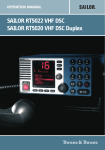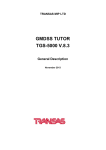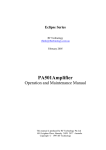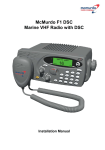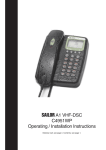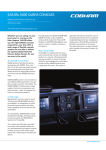Download Sailor RT4822 Specifications
Transcript
Sales Introduction SAILOR RT5022 Sales Introduction SAILOR RT5022 – Version 1.0 HFY th Thrane & Thrane, April 6 2005 Page 1 of 19 Content: 1. Introduction....................................................................................................................................................... 3 1.1 2. Background ............................................................................................................................................................... 3 Market............................................................................................................................................................... 4 2.1 2.2 3. SOLAS market ............................................................................................................................................................ 4 Fishing and other segments....................................................................................................................................... 4 Product description ........................................................................................................................................... 5 3.1 Unique features: ........................................................................................................................................................ 6 3.1.1 Unique features for the user:............................................................................................................................ 6 3.1.2 Unique features for the distributor: ...................................................................................................................7 3.1.3 Unique features for the dealer/installer.............................................................................................................7 3.2 Man Machine Interface (MMI).................................................................................................................................... 8 3.3 Displays ..................................................................................................................................................................... 8 3.3.1 Dimming .......................................................................................................................................................... 9 3.4 Replay ....................................................................................................................................................................... 9 3.5 Handset - HS5001...................................................................................................................................................... 10 3.6 Only one model: Channels tables Int, US, BI and ATIS in the same unit...................................................................... 11 3.7 Built-in loudspeaker .................................................................................................................................................. 11 3.8 Powerfull transceiver ................................................................................................................................................. 11 3.9 Dual Watch and Scanning.......................................................................................................................................... 11 3.10 Control Unit - CU5000........................................................................................................................................... 11 3.11 Connection box CB5009 ....................................................................................................................................... 12 3.12 Extension box EB5008.......................................................................................................................................... 12 3.13 LAN box LB5007................................................................................................................................................... 13 3.14 Other peripheral equipment................................................................................................................................. 13 3.14.1 GPS input........................................................................................................................................................ 13 3.14.2 AUX controls ................................................................................................................................................... 13 3.14.3 Voyage Data Recorder Interface ...................................................................................................................... 13 3.15 Automatic restart after abnormal power-down ..................................................................................................... 13 4. Installation ....................................................................................................................................................... 13 Built-in switch-mode power supply .................................................................................................................................... 13 4.1 Typical installations .................................................................................................................................................. 14 4.1.1 Full installation including a printer ................................................................................................................. 14 4.1.2 Typical SOLAS installation ............................................................................................................................... 14 4.2 Programming............................................................................................................................................................ 15 4.2.1 MMSI .............................................................................................................................................................. 15 4.2.2 P-channels...................................................................................................................................................... 15 4.2.3 List of MMSI numbers for vessels and coast stations........................................................................................ 15 5. 6. 7. 8. Service .............................................................................................................................................................15 Warranty ..........................................................................................................................................................15 Approvals .........................................................................................................................................................15 Future development .........................................................................................................................................16 8.1 8.2 8.3 9. Local anguage menus ............................................................................................................................................... 16 Squelch setting per channel...................................................................................................................................... 16 Scrambling ............................................................................................................................................................... 16 Technical specification ..................................................................................................................................... 17 9.1 9.2 9.3 9.4 9.5 General..................................................................................................................................................................... 17 Receiver.................................................................................................................................................................... 17 Transmitter ............................................................................................................................................................... 17 DSC facilities ............................................................................................................................................................. 18 Telephony................................................................................................................................................................. 18 9.5.1 DSC ................................................................................................................................................................. 18 9.6 Transmitter Requirements......................................................................................................................................... 19 9.6.1 Telephony ....................................................................................................................................................... 19 9.6.2 DSC ................................................................................................................................................................. 19 Sales Introduction SAILOR RT5022 – Version 1.0 HFY th Thrane & Thrane, April 6 2005 Page 2 of 19 1. Introduction Thrane & Thrane is pleased to introduce the new SAILOR RT5022 VHF, which is designed out of respect to the strong history of developing SAILOR VHFs, and to the state-of-the-art technology and innovation of Thrane & Thrane. The RT5022 is a VHF DSC Class A that meets the requirements of today’s seamen and brings strong new exiting features to the market! The SAILOR RT5022 replaces the SAILOR RT4822/SKANTI VHF 1000 DSC, which will be phased out during 2005. Please see separate letter regarding this. 1.1 Background Through VHFs like the RT144 and the RT2048, SAILOR has earned a strong reputation as the leading VHF brand in the professional maritime market. In the GMDSS market, the SAILOR RT4822 and the SKANTI VHF 1000 DSC have been the leading VHFs since their launch. In the development of the next generation VHF, the task to the Thrane & Thrane developing team was to design a product that can fulfil this legacy; “SAILOR VHFs have to be the best in the market!” The task was easy to identify, but definitely more difficult to achieve. We believe we have made a strong attempt to achieve this goal, and the feedback from the test installations has also been very positive. “The best VHF in the market”, covers several areas. Most importantly, it has to be the best to the user, but also the needs of the installer, the dealer and the distributors is part of such a definition. There are some basic elements, which identify what is the best for the user, and among these, is a simplified operation (MMI) making the usage easy. The process of designing the SAILOR RT5022 has been carried out through heavy investigations in the market, interviewing end users, discussing their usage and needs, collecting information from numerous distributors through workshops and interviews, and discussing details and testing these with distributors and end users. A highly skilled and experienced team of Thrane & Thrane engineers, along with MMI experts, have been involved in specifying and developing the SAILOR RT5022. The MMI was developed and tested both together with former captains and seamen in simulation environment, and tested in real installations. The collected information led to clear specifications of the need for a VHF for today’s users: - Easy to use Separate standard VHF functions from DSC functions Great sound Good tactile feeling in buttons and knobs as well in handset Sales Introduction SAILOR RT5022 – Version 1.0 HFY th Thrane & Thrane, April 6 2005 Page 3 of 19 - Reliability Strong performance Good vision/Easy to read of primary VHF settings in the display Strong durability And many more details. Basically the users simply want an easy-to-use VHF with strong performance on the primary VHF features. The more advanced features/settings shall be separated from the VHF features. At the same time, undiscovered needs were revealed. This resulted in new revolutionary features! The feedback from the final testing was clear. The new SAILOR RT5022 fulfils the expectations and traditions of a SAILOR VHF, and the new RT5022 is going to set new standards for VHFs in the market! As one captain said: “This is a VHF that will set the standard, as the SAILOR RT144 did!” We hope he is right! 2. Market The SAILOR RT5022 replaces the very successful SAILOR RT4822/SKANTI VHF 1000 DSC in the market. The SAILOR RT5022 is a GMDSS VHF DSC Class A and fulfils the requirements for vessels for which GMDSS VHF is mandatory. The SAILOR RT4822 and the SKANTI VHF 1000 DSC have been very successful in the market, and possess a major market share in the part of the SOLAS and fishing market, where GMDSS VHF’s are required. 2.1 SOLAS market There are more than 63,000 vessels in the SOLAS market, and these were all fitted with GMDSS equipment during the late 90-ties. In general electronic equipment can be expected to last for 712 years, depending of the quality. Already now it is seen that the demand for replacing the first GMDSS installations is increasing. It can be expected that this tendency will continue in the next years. The number of new buildings of vessels in the SOLAS segment has been booming the last couple of years, and the number of vessels leaving the shipyards these years is approx. 2,000 per year. All of these will normally fit two VHF GMDSS Class A if approved for sea area A3, which is quite common. 2.2 Fishing and other segments The VHF Class A is also used in the fishing fleets and other segments. The number of fishing vessels outnumbers the number of SOLAS vessels. In Europe alone there are more than 100,000 fishing vessels, and in the US more than 23,000 vessels. Other regions have also large fishing fleets. Sales Introduction SAILOR RT5022 – Version 1.0 HFY th Thrane & Thrane, April 6 2005 Page 4 of 19 Only part of these vessels is requested to fit a VHF DSC Class A. Most of the large fishing vessels have already been fitted. In some regions the small vessels are now requested to fit GMDSS, and more regions are expected to implement GMDSS into the entire fleet. For quite some time it has been seen that some fishing vessels fit a SAILOR VHF DSC Class A, even though they may need to fit only a Class D. When asked why they explain that they want to fit a top-of-line VHF and they prefer the SAILOR VHFs. In the fishing market, a VHF is considered a working tool - like the hammer to the carpenter! This is a product used a lot during the day - for communication to other vessels as well as to shore and harbours. The ease of use, the reliability and the powerfulness are all among the important criteria when the captains choose their VHF. 3. Product description The new SAILOR RT5022 is a VHF with built-in DSC Class A. Part No. 8050220009 8050220000 8050220006 Description SAILOR RT5022 VHF DSC Class A, Blue SAILOR RT5022 VHF DSC Class A, Green SAILOR RT5022 VHF DSC Class A, Black/Grey The following accessories are available: Part no. 8050000009 8050000000 8050000006 739814 8050090006 8050080006 8050070007 8050060007 80497010 801194 Type no. CU5000 CU5000 CU5000 CB5009 EB5008 LB5007 SB5006 Description Semi-intelligent control unit, Blue Semi-intelligent control unit, Green Semi-intelligent control unit, Black Flush mount kit for RT5022 Connection box Extension box LAN box Service box LS4970 Loudspeaker 5 watt N163S Power supply, 24V DC Sales Introduction SAILOR RT5022 – Version 1.0 HFY th Thrane & Thrane, April 6 2005 Page 5 of 19 3.1 Unique features: The SAILOR RT5022 offers many unique features, and some of these have never been seen in the market before. 3.1.1 Unique features for the user: • Replay: o Easy replay of incoming communication • Separate displays for standard VHF functions and other settings, e.g. DSC • Large tactile buttons and knobs • • • • • • • • • • • • Two displays: o 7 segment display with all basic VHF functions Very large display for easy reading at a distance Optimized for reading in very wide angles Provides the operator with a quick overview of the standard VHF settings o Graphic display with all settings Sleep mode function for reduced light on bridge at night o Red text for good night vision o Inverted text for easy reading o Dimming function for good night vision Marine AR anti-reflection filter Powerful built in loudspeaker MMI: o Very intuitive and easy to use menu o Quick selection function Mute alerts button Built-in full DSC Large distress button 25 to 1W switch button Dual Watch button Ergonomic and ruggedized handset HS5001 o Powerful earpiece o Designed for noise reduction in the microphone o Large PTT key/button o Water resistant according to IP66 (see explanation later on) o Strong cradle for handset o Strong spiral cord Self-test Automatic restart after abnormal power-down Sales Introduction SAILOR RT5022 – Version 1.0 HFY th Thrane & Thrane, April 6 2005 Page 6 of 19 The CU5000 is also offering unique design and features: • Replay • Almost identical 7 segment display as RT5022 for easy identification o Almost same display functions in CU5000 as in RT5022 o Dimming • Water resistant according to IP66 (see explanation later on) • Ergonomic and heavy duty designed handset (same as HS5001) • Volume control • Channel selection • Squelch control • Mute alert o Mute alert. Does mute the alert on the RT5022, but does not cancel the alert • 25 to 1W switch button • Flexible installation: o Handset separated from Control Unit o Dimensions HxWxD: 100x100x36 mm 3.1.2 Unique features for the distributor: • • • • • • Only one model o Model covers both International, US and BI. Easy programming Good and solid packaging which is easy to stock and to ship Easy service o Only three boards which do not need electrical aligning 12-24V DC Nominal (10.8 – 31.2V DC) Software update via standard browser (HTML) 3.1.3 Unique features for the dealer/installer • Only one model • Programming of MMSI from front panel • HTML based easy to use programmer (SB5006) o Easy upload of total programming o Easy upload of addresses o Easy upload of P-channels • Easy mount and solid powerplug • 12-24V DC nominal (10.8 – 31.2V DC) • Fuse easy to access • Flexible installation: o Bracket o Flush mount – fits the wholes left by the RT4822/VHF 1000 DSC Dimensions HxWxD: 100x200x210 • Interface direct to VDR • CU5000 • CB5009 for easy installation with ship’s cables • EB5008 for easy installation of extra loudspeakers on e.g. bridge wings Sales Introduction SAILOR RT5022 – Version 1.0 HFY th Thrane & Thrane, April 6 2005 Page 7 of 19 3.2 Man Machine Interface (MMI) As mentioned previously, serious efforts have been put into developing the “best in class” MMI. The SAILOR RT5022 is a work tool, and it is important that the users find it easy to use - also in critical or hasty situations. The SAILOR RT5022 has two displays separating the main standard VHF functions from the DSC and setting functions. This simplifies the usage, and the important information as e.g. channel, volume and output power is presented to the end user at a quick glance. The primary functions are direct adjustable by one function knob, e.g. knob for volume, knob for squelch, and channels can be selected direct from the keypad. All the prioritised buttons are larger than seen before on a SAILOR VHF, and the less prioritised buttons are smaller. The most frequently used functions - the volume and the squelch - are operated by knobs with tactile steps. The level of these two functions is indicated in the 7-segment display by two bars. The menu has been thoroughly developed and tested by users in order to ensure an understandable and intuitive menu. All menu lines have a number and can be chosen by quick selection (simply press the number of the menu you want to access). 3.3 Displays As mentioned previously there are two displays: The 7-segment display on top, which indicates all the primary VHF functions, and the graphic display below for DSC and less used settings. All text and indicators are red, which ensures that the VHF does not disturb the night vision on the bridge. This is also ensured by the dimming function. The 7-segment display is designed to provide the operator a quick overview of the VHF function, e.g. the channel chosen. The 7-segment display is designed to be readable from very wide angles, allowing the user to read the display from almost any angle. The graphic display is also easy to read from wide angles. A glass in front of the displays includes a Marine AR filter that reduces the reflections from the sun and other lights that may make the display less readable or be annoying to the user. Sales Introduction SAILOR RT5022 – Version 1.0 HFY th Thrane & Thrane, April 6 2005 Page 8 of 19 The 7-segment display shows following information: • • • • • • • • • Channel 1/25 watt output power indicator Channel table selection (Int, US or BI) Volume level (6 bars, but 12 levels) Squelch level (6 bars, but 12 levels) Dual Watch Tx indicator Call indicator DSC Alarm indicator The graphic display is used for all settings and the DSC menu. The menus can be operated by using the UP, DOWN, MENU BACK and OK key. The menus are activated by pressing the Menu buttons. All menus have a number, and the menus can be selected by pressing the respective number. The graphic display has a sleep mode function. When this function is activated the graphic display can go into sleep mode, whenever it is not activated. The bright background light intensity usually inherent to LCD displays is well known to be very annoying on vessels at night, as it disturbs the night vision and the light may reflect in the windows on the bridge. The sleep mode function solves this problem in the RT5022. The newest regulations require that the display show UTC time, MMSI number and position and time of position report. The RT5022 fulfils these requirements. 3.3.1 Dimming The dimming function allows the user to set the right level direct on the front panel by pushing just one button. When pressed once the light becomes brighter, and pressed twice the light is reduced. The contrast can be set in the menu. 3.4 Replay This is a completely new function, which has never been seen in the market before. Pattern applications are pending. The SAILOR RT5022 constantly records the latest 90 seconds of communication received. The communication can then be replayed simply by pressing the Replay button. The graphic display indicates on which channel the communication was received, the time and date, and the duration in seconds. The RT5022 records communication only on the channel selected. 90 seconds may sound a short time, but it can easily cover incoming communication for a very long period! Sales Introduction SAILOR RT5022 – Version 1.0 HFY th Thrane & Thrane, April 6 2005 Page 9 of 19 This revolutionary new function is a result of the information collected from seamen, who informed us that in some critical situations they had had problems hearing what the other party was saying. By the Replay function the user can press the button and the communication is repeated. During our tests some captains have found new ways of using this function. From time to time, the operator may have to leave the bridge in the harbour, and by that they may miss calls. They can now use the Replay button to get updated on the latest call. As one captain on a tug boat said: “I might leave the bridge for an hour for lunch in harbour, and when I return I can check the Replay to see if somebody have asked for our support”. 3.5 Handset - HS5001 One of the new handset HS5001 (included with the RT5022) can be connected directly to the VHF. The HS5001 is specially designed for the harsh environment at sea. The design has taken the “feeling” of holding and operating the handset into account. The edges are rounded off to make it comfortable to hold, The PTT switch is placed centrally in the handset in order to make it feel natural to activate the switch when the operator wants to communicate. The curvature of the handset is designed to suit the typical head contour making it comfortable and natural to operate. The earpiece is designed to make it fit the ear in order to reduce the noise from outside factors. The handset is designed to reduce outside factor noise in the microphone - especially wind that often can create an unpleasant noise during transmission. Exposed equipment and IP66 The HS5001 is designed for and tested as “exposed equipment”, which includes water resistance according to IP66. This test simulates the effects of rain, sea spray and light breaking seas on equipment. The test shall be carried out by spraying the equipment from all practical directions with a stream of water from a 12.5mm nuzzle and applying a 100l/min water level from a distance of 3 metre’s. Test duration is approximately 30 minutes. After the test a performance check on the equipment is performed. A test for damage and unwanted water ingress is performed. Due to the pressure of water the IPX6 test is much tougher to comply with than IPX7, and is much thus more. This is why the HS5001 and the CU5000 have been designed, tested and approved to according to IP66. The HS5001 provides integrated spiral cord connecting to the RT5022 through a 9-pole Sub-D plug. The cradle supplied with the handset is rugged and ensures that the handset can be mounted in any angle, and a solid grip is necessary to lift the handset from the cradle. Sales Introduction SAILOR RT5022 – Version 1.0 HFY th Thrane & Thrane, April 6 2005 Page 10 of 19 3.6 Only one model: Channels tables Int, US, BI and ATIS in the same unit To a great extent the distribution channel logistics have simplified, as the SAILOR RT5022 is available only in one version. Upon the installation of the VHF the installer chooses the channel table and type. By this, the distribution channels need only to carry one version in stock even though the need for a VHF DSC Class A differs between units with International channel settings, US channel settings, or BI settings. Also ATIS and ATIS killer can easily be chosen on the RT5022 by the installer. This will simplify the logistics in the distribution channels and make it easier to have the adequate version on stock. 3.7 Built-in loudspeaker The built-in loudspeaker is very powerful and efficient. It ensures the utmost signal - even in very noisy conditions. The loudspeaker is capable of an output of 5 watt and is controlled direct from the volume knob. If this is not be sufficient, an external 5W loudspeaker can be connected to the SAILOR RT5022 via the Option port. If the loudspeaker is connected directly to the RT5022 or to the CB5009, the volume knob of the RT5022 will control the volume of the loudspeaker. 3.8 Powerfull transceiver The RT5022 provides a very powerful 25W transmitter. The specially designed heatsink ensures that the RT5022 can be keyed for a very long time without overheating, making the transmitter extremely durable. The receiver is very sensitive and selective, which reduces blocking and intermodulation by other VHF or AIS products installed. 3.9 Dual Watch and Scanning The SAIILOR RT5022 features a Dual Watch function, which is easy to select from the front panel by one push on the DW button. The RT5022 has four ways of scanning. One is set to scan all channels. The user can program three scanning tables with up to 10 channels (plus channel 16) per table. 3.10 Control Unit - CU5000 The Control Unit CU5000 is designed for installation on bridge wings or other secondary places where the user wants to be able to operate the RT5022. Up to two CU5000 can be connected to the RT5022. During the research we have received the clear message from the users that they want to access only the basic functionalities from these positions. The DSC is to be used only direct from the RT5022. Sales Introduction SAILOR RT5022 – Version 1.0 HFY th Thrane & Thrane, April 6 2005 Page 11 of 19 The following functions are available in the CU5000: - Volume control (including external loudspeaker) - Squelsh control - Dimming - Channel selection (scroll up and down, with auto stop on Channel 16) - 25W to 1W switch button - Replay - Mute alerts Only relevant features are available, thus making the operation of the CU5000 very easy. The CU5000 is designed for and tested as “exposed equipment”, including water resistance according to IP66, as mentioned in the paragraph about the HS5001. The large 7-segment display is almost identical with the display of the RT5022, making the identification and operation intuitive. The buttons are large, but has been modified in order not to make the CU5000 to big. The volume- and squelch knobs on the RT5022 have been changed to scroll buttons, in order to make them water resistant. The CU5000 includes one HS5001. The HS5001 is connected to the Control Unit by a spiral cable making it easy to install in an ideal position. The cable cannot be dismounted from the Control Unit as it is sealed in order to prevent water ingress. The CU5000 is supplied with a fixed cable for connection to the CB5009. The dimensions of the Control Unit are 100x100x36 mm. The HS5001 is separated from the unit to secure easy and flexible installation. 3.11 Connection box CB5009 The CB5009 has been developed for easy installation and integration of accessories and other peripheral equipment. Such equipment can be the GPS (for position input), an external loudspeaker (e.g. the LS4970), the LAN box LB5007, the Alarm Panel AP4365, or the CU5000. The CB5009 is designed for easy installation of ship’s cabling. 3.12 Extension box EB5008 The EB5008 is used for installing an external loudspeaker near the CU5000. This will also allow the user to control the volume in the external loudspeaker from the CU5000. Sales Introduction SAILOR RT5022 – Version 1.0 HFY th Thrane & Thrane, April 6 2005 Page 12 of 19 3.13 LAN box LB5007 In a few countries it may be to connect the VHF to a printer. In such installations the LAN box LB5007 has to be used. The LB5007 has to be connected to a LAN to Parallel switch box, which can be bought locally in most PC shops. 3.14 Other peripheral equipment The RT5022 is designed for integration into the alarm panel AP4365 for installations where this is required. 3.14.1 GPS input The RT5022 can be connected to the vessel’s GPS through the Connection port. The RT5022 supports the following NMEA sentences in accordance with IEC61162-1; GLL, RMC, ZDA, GGA, VTG, GNS. 3.14.2 AUX controls The RT5022 offers two AUX relay outputs. These can individually be set to one or more channels, and control external relays. 3.14.3 Voyage Data Recorder Interface The SAILOR RT5022 is prepared for interfacing direct to a VDR or through the CB5009. 3.15 Automatic restart after abnormal power-down If for some reason the power fails, the RT5022 will automatically power up again, if the power resumes within 10 minutes. If the power is resumed within 1 minute the RT5022 will start up with the same settings as prior to the power failure. If the power failure lasts more than one minute the RT5022 will start up with the settings of the last time it was turned off normally. The RT5022 includes Super-Cap, instead of an internal battery. No battery inside the VHF needs to be replaced periodically. 4. Installation As mentioned priviously the RT5022 is designed for easy and fast installation. The dimensions (width and height) of the RT5022 are the same as of the SAILOR RT4822 and the SKANTI VHF1000 DSC, which makes replacement easy of one of these VHFs in the market. The connectors on the back of the VHF is easy accessible, and the new improved power plug is a very solid connector which can easily be plugged in. Built-in switch-mode power supply The RT5022 has a built-in a switch-mode power supply and requires 12-24 VDC nominal (10.8 –31.2 V DC), thus it requires no 24 – 12 volt power regulator. Sales Introduction SAILOR RT5022 – Version 1.0 HFY th Thrane & Thrane, April 6 2005 Page 13 of 19 4.1 Typical installations As seen above the SAILOR RT5022 is very flexible to install and many combinations are available to fit the unit in order to fulfil the individual vessel’s requirement. Below you see some - but not all - of the possible combinations: 4.1.1 Full installation including a printer 4.1.2 Typical SOLAS installation This installation will probably be the standard installation on SOLAS vessels with two control units for the bridge wings. Sales Introduction SAILOR RT5022 – Version 1.0 HFY th Thrane & Thrane, April 6 2005 Page 14 of 19 4.2 Programming The programming of the RT5022 is designed to simplify the process for the installer. The MMSI number and the version type (International/US/BI/ATIS) can be programmed from the front panel. The service software uses standard web browsing technologies and is very easy to use. The Service Box SB5006 is connected to the RT5022 and can be used for uploading total programming files, making it easier to load all relevant settings. 4.2.1 MMSI During installation the RT5022 will request a MMSI number to be entered the first time it is turned on. If at a later stage the MMSI needs to be changed, this will have to be done using a Service Box SB5006 as it is not the intention that only authoritized persons can do this. This is a requirement by the authorities. 4.2.2 P-channels Programming of P-channels requires the Service Box (SB5006). Authorities require that only authorized and trained technicians shall have access to programming of channels. Up to 30 private channels can be programmed in three separate banks designated F, P or L. Each bank contains 10 private channels. 4.2.3 List of MMSI numbers for vessels and coast stations This can be done from the front panel of the RT5022, but it is easier to do by using the SB5006. If the installer is programming by the SB5006, the whole programming can be saved on the PC. The saved file can then easily be uploaded in another VHF. This eases the programming of standard settings, e.g. MMSI numbers for other vessels, coast stations and P-channels. 5. Service The SAILOR RT5022 is designed for easy and quick repair and maintenance. The unit consists of three boards and one front unit, which can easily be replaced without any electrical adjustments. The fuse is easy to access as it is placed on the back of the unit below the power connector. 6. Warranty The SAILOR RT5022 is covered by the standard Thrane & Thrane warranty concept. 7. Approvals The RT5022 has received the wheelmark approval (MED) and the FCC approval. The certificates are available on the T&T extranet. Sales Introduction SAILOR RT5022 – Version 1.0 HFY th Thrane & Thrane, April 6 2005 Page 15 of 19 The following approvals have either been applied for or will be applied for within the near future: - US Coast Guard Russian Maritime Register (RMR) Morzviasputnik CCS Canadian Maritime approval (CMA) AMSA (Australia) Certificates will be available on the extranet as soon as they are received. 8. Future development We are sure that the new SAILOR RT5022 will improve our mutual competitiveness in the market. During the summer of 2005 new software will be released which will allow for further new exiting features. These can be loaded by the Service Box SB5006. Some of these features will be free of charge and can be loaded in all VHFs at no charge. However, some may require a charge from Thrane & Thrane. In order to activate these new features you will have to order a special code which is unique for each individual VHF. 8.1 Local anguage menus Among these new features is the opportunity of loading menus in local language. These can be loaded by the SB5006. The development of new language menus will be a process in which we will consult local partners. As this requires significant development tasks, not all languages can be expected. More details to be announced at a later stage. 8.2 Squelch setting per channel The squelsh can be set to a certain level for the individual channel. If the user is working on a specific channel, he will normally set the squelsh to a level that he finds adequate. If he chooses to change to another channel for a quick call, he will not have to set the squelch when he returns to his working channel. 8.3 Scrambling Another future feature is a scrambler. This will allow two or more VHF users to communicate on the VHF channels without anyone not-authorized and having the same specification to listen in. VHFs without the right code will not be able to listen in on the communication, even though they may detect that communication is going on. Sales Introduction SAILOR RT5022 – Version 1.0 HFY th Thrane & Thrane, April 6 2005 Page 16 of 19 9. Technical specification The SAILOR RT5022 fulfills and exceeds the technical specifications required by the authorities. 9.1 General Channels Frequency stability Aerial connectors Temperature range Supply voltage Supply voltage range Transceiver dimensions Transceiver weight All Int, US and BI channels. Up to 30 private channels in 3 separate banks designated F,P or L. Each bank contains 10 private channels. 25 kHz Simplex /Semi-duplex G3EJN for Telephony G2B for DSC. Better than ± 3 ppm Standard 50 ohm female SO239 -15 ºC to +55 ºC 12V to 24V DC nominal 10.8V to 31.2V DC H*W*D 100*200*210 mm 3.6 Kg 9.2 Receiver Frequency range Sensitivity for 20 dB SINAD CCITT weighted AF rated Power Internal L.S. Output for External L.S. Distortion S/N ratio Spurious emission Spurious response rejection Intermodulation response Co- channel rejection Adjacent channel selectivity Blocking level 149.30 – 163.75 MHz Below -121 dBm or 0.20 µV p.d. 5 watt in 8 ohm 5 watt in 8 ohm Less than 5 % Better than 43 dB Less than 0.25 nW Better than 74 dB Better than 73 dB Better than –10 dB Better than 74 dB Better than 94 dBµV Channel spacing Operation modes Modulation 9.3 Transmitter Frequency range RF output power High Low Adjacent channel power Conducted spurious emission Distortion S/N ratio 149.30 – 163.75 MHz 25W +0dB to –0.5dB 0.85 W +0.5dB to –1dB Better than 75 dB Better than 0.1 µW Better than 5 % Better than 46 dB Sales Introduction SAILOR RT5022 – Version 1.0 HFY th Thrane & Thrane, April 6 2005 Page 17 of 19 9.4 DSC facilities DSC operation According to Rec. ITU-R M.541-9 and Rec. ITU-R M.689-2 According to Rec. ITU-R M.493-11 Class A According to IEC 61162-1 GLL, RMC, ZDA, GGA, VTG, GNS DSC protocol Navigator interface -2 Better than 1*10 @ -121 dBm or 0,20 µV p.d. 1700 Hz ± 400 Hz 1200 baud Better than ± 1 Hz Better than –26 dB Symbol error rate Modulation Frequency error Residual modulation As mentioned above the Thrane & Thrane specifications for the SAILOR RT5022 exceed the specifications required by the ETSI standards. In the below tables is a comparison of the specifications that Thrane & Thrane requires from the VHF and the ETCI requirements. On all parameters Thrane & Thrane’s technologies exceed these. 9.5 Telephony Parameter MUS Distortion Adj. Ch. Selectivity Intermodulation Co-channel Max. S/N Blocking Spurious rejection Spurious Emission ETSI Requirement T&T Requirement -107dBm 10 % 70 dB 70 dB -10 dB 40 dB 90 dBµV 70 dB 1 nW -118dBm 5% 74 dB 73 dB -10 dB 43 dB 94 dBµV 74 dB 0,25 nW ETSI requirement T&T requirement -113dBm 73 dBµV 68 dBµV -8 dB 93 dBµV 73 dBµV 1 nW -119 dBm 77 dBµV 71 dBµV -8 dB 97 dBµV 77 dBµV 0,25 nW 9.5.1 DSC Parameter MUS Adj. Ch. Selectivity Intermodulation Co-channel Blocking Spurious rejection Spurious Emission Sales Introduction SAILOR RT5022 – Version 1.0 HFY th Thrane & Thrane, April 6 2005 Page 18 of 19 9.6 Transmitter Requirements 9.6.1 Telephony Parameter High Power Low Power Adj. Ch. Power Spurious emission Max. S/N ETSI requirement 25W – 6W 1W +0dB/-10dB 70 dB 0.25 uW 40 dB T&T requirement 25W +0dB/-1dB 1W +0dB/-1dB 75dB 0.10 uW 43 dB ETSI requirement 25W to 6W 70 dB 0.25 uW T&T requirement 25W +0dB/-1dB 75dB 0.10 uW 9.6.2 DSC Parameter High Power Adj. Ch. Power Spurious emission Sales Introduction SAILOR RT5022 – Version 1.0 HFY th Thrane & Thrane, April 6 2005 Page 19 of 19



















